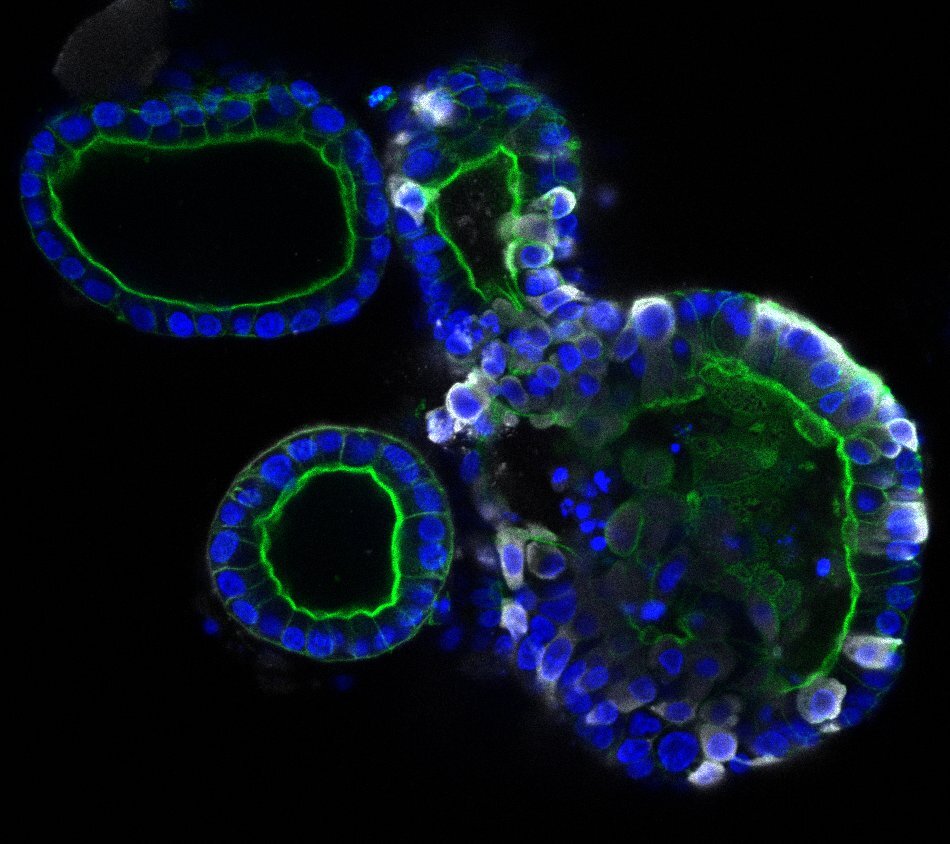Source: COVID-19 Research May 02, 2020 5 years, 6 months, 2 days, 23 hours, 4 minutes ago
COVID-19 Research: Dutch medical researchers from the Hubrecht Institute in Utrecht, Erasmus MC University Medical Center Rotterdam, and Maastricht University in the Netherlands have discovered that the SARS-CoV-2 coronavirus which causes the deadly COVID-19, can infect cells of the intestine and multiply there.
.jpg) Illustration of a villus in the intestine with a zoom-in to an electron microscopy
Illustration of a villus in the intestine with a zoom-in to an electron microscopy
image of coronavirus SARS-CoV-2 (dark circles) at the edge of an intestinal cell.
Credit: Kèvin Knoops, Raimond Ravelli & Maaike de Backer, copyright: Maastricht University
Utilizing state-of-the-art cell culture models of the human intestine, the research team have successfully propagated the virus in vitro, and monitored the response of the cells to the virus, providing a new cell culture model for the study of COVID-19.
The research could explain the observation that approximately 38 per cent of COVID-19 patients experience gastrointestinal symptoms such as diarrhea, and also the fact that the virus often can be detected in stool samples. The results of this study were published in the scientific journal
Science.
https://science.sciencemag.org/content/early/2020/04/30/science.abc1669
Typically, individuals with COVID-19 show a variety of symptoms associated with respiratory organs such as coughing, sneezing, shortness of breath, and fever and the disease is transmitted via tiny droplets that are spread mainly through coughing and sneezing.
However about 38 percent third of the patients also have gastrointestinal symptoms, such as nausea and diarrhea. In addition, the virus can be detected in human stool long after the respiratory symptoms have been resolved. This suggests that the virus can also spread via so-called "fecal-oral transmission."
Despite the fact that the respiratory and gastrointestinal organs may seem very different, there are some key similarities. A particularly interesting similarity is the presence of the ACE2 receptor, the receptor through which the SARS-CoV-2 virus can enter the cells. The inside of the intestine is loaded with ACE2 receptors. However, until now it was unknown whether intestinal cells could actually get infected and produces virus particles.
 Intestinal organoids, the right one infected with coronavirus SARS-CoV-2. The
Intestinal organoids, the right one infected with coronavirus SARS-CoV-2. The
coronavirus is colored white, the organoids themselves are colored blue and
green. Credit: Joep Beumer, copyright Hubrecht Institue
The Dutch team of researchers set out to determine whether the SARS-CoV-2 virus can directly infect the cells of the intestine, and if so, whether it can replicate there as well. They used human intestinal organoids or tiny versions of the human intestine that can be grown in the lab.
Urgent Plea for help. We need help to financially sustain our website and also our other research an
d international community projects. Please support us by making a donation via paypal. Thank You. https://www.thailandmedical.news/p/sponsorship
The researchers said, "These organoids contain the cells of the human intestinal lining, making them a compelling model to investigate infection by SARS-CoV-2."
Upon adding the SARS-CoV-2 coronavirus to the organoids, they were rapidly infected. The coronavirus enters a subset of the cells in the intestinal organoids, and the number of cells that are infected increases over time.
Utilizing electron microscopy, an advanced way to visualize different components of the cell in great detail, the researchers found virus particles inside and outside the cells of the organoids.
The medical researchers investigated the response of the intestinal cells to the virus with RNA sequencing, a method to study which genes are active in the cells. This revealed that so-called interferon stimulated genes are activated. These genes are known to combat viral infection.
The team also cultured the organoids in different conditions that result in cells with higher and lower levels of the ACE2 receptor, through which SARS-CoV-2 can enter the cells. To their surprise, they found that the virus infected cells with both high and low levels of the ACE2 receptor. Ultimately, these studies may lead to new ways to block the entry of the virus into our cells.
Dr Bart Haagmans (Erasmus MC) commented, "The observations made in this study provide definite proof that SARS-CoV-2 can multiply in cells of the gastrointestinal tract. However, we don't yet know whether SARS-CoV-2, present in the intestines of COVID-19 patients, plays a significant role in transmission.”
He added, “Our findings indicate that we should look into this possibility more closely. The current study is in line with other recent studies that identified gastrointestinal symptoms in a large fraction of COVID-19 patients and virus in the stool of patients free of respiratory symptoms. Special attention may be needed for those patients with gastrointestinal symptoms. More extensive testing using not only nose and throat swabs, but also rectal swabs or stool samples may thus be needed.”
The medical researchers are continuing their collaboration to learn more about COVID-19. They are studying the differences between infections in the lung and the intestine by comparing lung and intestinal organoids infected with SARS-CoV-2.
It is also interesting that as more mutated strains of the SARS-CoV-2 coronavirus emerges; more patients are not only manifesting gastrointestinal symptoms but other new clinical manifestations such as blood clotting, damage of blood capillaries etc.
For more latest developments on
COVID-19 research, keep logging to
Thailand Medical News.
Urgent Plea for help. We need help to financially sustain our website and also our other research and international community projects. Please support us by making a donation via paypal. Thank You. https://www.thailandmedical.news/p/sponsorship
.jpg)
